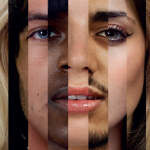Seven Days:

 Seven Days is the new TV programme that follows a diverse group of Nottingham's most interesting people, living and working in Notting Hill who want the public's opinion as to what they should do next in their lives. It is aired by Channel 4.
Seven Days is the new TV programme that follows a diverse group of Nottingham's most interesting people, living and working in Notting Hill who want the public's opinion as to what they should do next in their lives. It is aired by Channel 4.The documentary starts off with black sentences against a white screen reading 'What you are about to see, happened in the last seven days. To people who live or work in Notting Hill West London. Tell them what you think.' This introduction sums up the meaning of this documentary and "tells" the audience what they have to do. It entitles the public to not only have their own opinion, but the ability to voice it. This is a rare opportunity as most are only there to observe.
After this, it goes into 3 arial shots of the city to set the scene, then a few short clips of things happening that day; people dancing on the street, newspaper headline for that day, someone at the dentist. I really like this idea because it shows a brief insight into where these people live, already giving the viewers a lot more knowledge, only a few seconds in.
Following this, the characters are introduced. The first to be shown are two girls, sitting inside a cafe. They are introduced by white text with their name and their job beneath that. It doesn't stay on these girls for long. It then goes to two guys in their home, but they are not introduced. It then goes back to the girls, but this time showing the name of the cafe they are in. Not long after this it introduces us to someone else, Hannah, an Interior Designer. It then cuts back to the girls in the cafe, and then back to Hannah. It is showing two different locations with different people weaving into each other. This idea is clever because it shows contrasts between people that live there. It kept my attention longer because two different things were happening at once, so I wasn't stuck in the same scene for too long. These short scenes enabled the editors to cut out less interesting scenes more discretely.
Not only does the text show people's names, it also tells us why someone is where they are or what is going on, like 'Malcom's new buy-to-let property', as he enters the house, because we would have not known this otherwise.
None of the actors hide the fact they are being filmed. They will openly talk about the cameras and if they are distracting them from they're everyday lives. This sometimes happens in reality documentaries, but you would never see this in an education documentary such as 'Life' - the nature documentary.
Most of the shots are mid- shots and long shots. All of them are level with the people they are filming; we're not seeing lots of sophisticated shots such as arial shots or with objects in the way. This keeps the viewer's focus, and enables them to feel like they are actually there. Sometimes during less intense conversation scenes, there will be shots of people's feet as they walk etc but this is discrete and I think it works well.
Each scene usually starts with a few short clips of the surroundings, and then the rest are usually long clips that have the camera panning the scene, instead of lots of different angles which would make me feel as though what is happening isn't real, but acted. It would seem more like a reality TV show instead of a documentary.
Throughout the show, a white box at the bottom of the screen appears with the show's web address on it, reminding the audience they can go on it and voice their opinion.
This sort of documentary is very similar to something I would like to produce because it follows the lives of people in a way I really like. It consists of hand held shots and steady shots, and makes the viewer feel as though they are there in the scene.